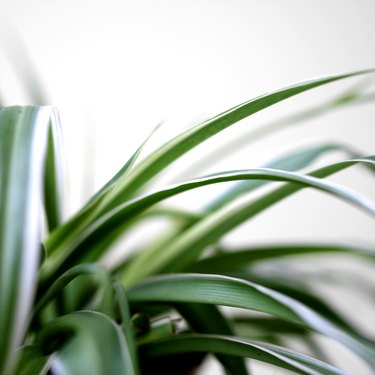
Tiny and flylike, fungus gnats can become a problem for many different types of houseplants, including the spider plant (Chlorophytum comosum). Unlike many spider plant bugs and spider plant diseases, fungus gnats cause little harm to the host plant, although they can become a nuisance in large numbers. Adopting sound cultural practices can help keep these pesky pests at bay.
What Are Fungus Gnats?
Video of the Day
Fungus gnats are small, winged insects. They are usually less than 1/8 of an inch in size. Fungus gnats lay their eggs in the soil of houseplants. The larvae that emerge from the eggs are legless and wormlike and have dark heads. The larvae feed on decaying organic matter in the soil and in rare cases may also feed on the root hairs below the soil line. It takes about a month for the larvae to develop into adult gnats.
Video of the Day
Any kind of houseplant, including a spider plant, can become a host for fungus gnats. These insects tend to be most active in late winter leading into early spring. Adult fungus gnats often congregate around light sources and windows, which is how you may first notice their presence. You can also check for fungus gnat larvae by simply placing a few potato slices on the top of the soil. If there are gnat larvae in your spider plant, the maggots will make their way to the surface of the soil to feed on the potato slice.
Gnats on a Spider Plant
The larvae of fungus gnats thrive in moist soil conditions, which is why fungus gnats are often seen in spider plants and other houseplants that are overwatered. While you don't want to let your plant wilt, if your spider plant has gnats, be sure to allow the growing medium to dry out almost completely between waterings, as this can often be enough to kill many of the larvae in the soil.
You can also place sticky cards around the plant. While this will not control larvae, it can help trap some of the adult fungus gnats that may be flying around. Sticky cards are available commercially, or you can make your own by applying a layer of petroleum jelly on a piece of thin cardboard, like an index card.
Soil infested with fungus gnat larvae can be treated with a bacteria known as Bacillus thuringiensis subspecies israelensis, which kills the maggots. Another way to eliminate fungus gnat larvae in spider plants is to simply repot the plant. When you do this, be sure to gently wash off any old soil from the roots to prevent a reinfestation.
Other Spider Plant Bugs
While excessive watering can lead to root rot and create optimal conditions for fungus gnats to develop, underwatering a spider plant can produce the kind of dry environment favored by spider mites, another common pest of many types of houseplants. These tiny arachnids feed on the sap of leaves. While hard to see with the naked eye, you might notice the webbing that spider mites create between leaves. Providing adequate humidity can help prevent spider mite infestations.
Spider plants can also become infested with aphids and scales, which are small, sap-sucking insects. They produce honeydew, a sweet, sticky substance that can become a breeding ground for black sooty mold. Whiteflies can occasionally be an issue with indoor spider plants.